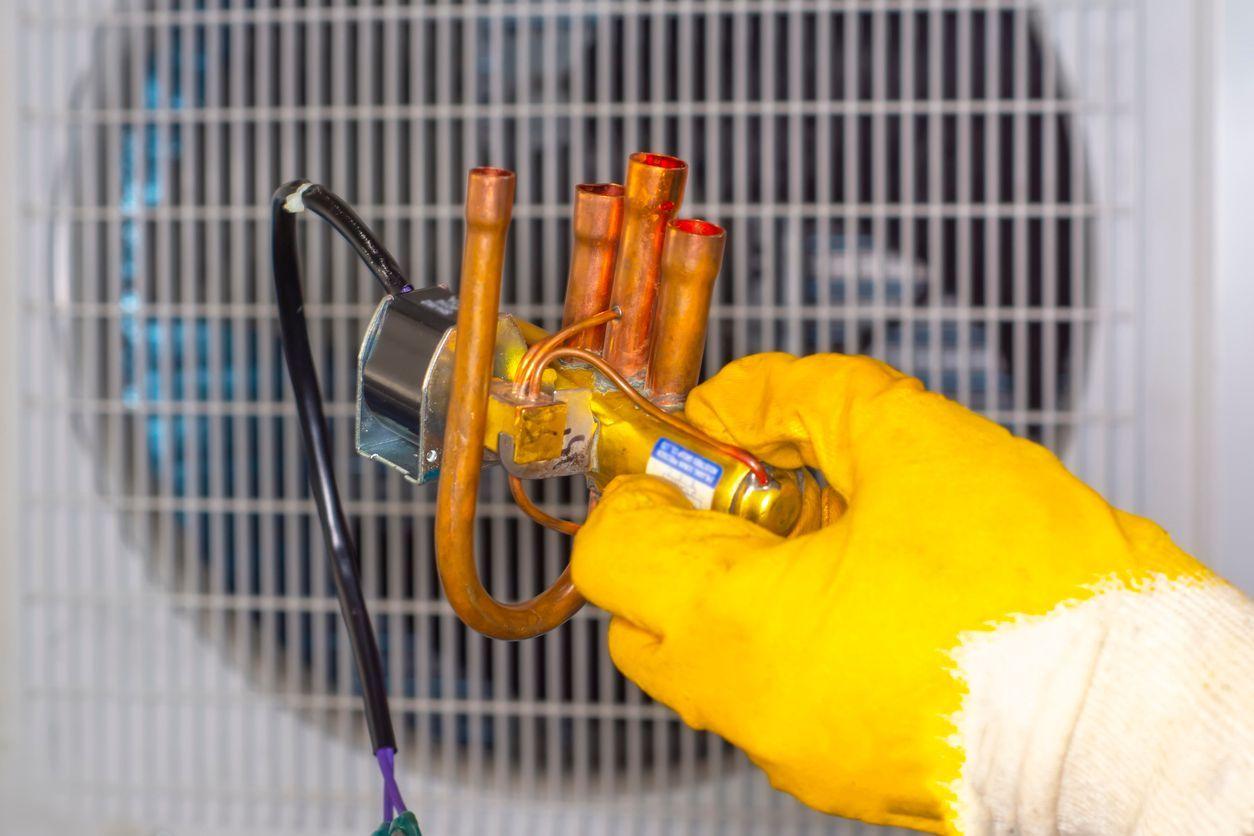Why Is My Heat Pump Reversing Valve Stuck?

One of the most attractive features of a heat pump system is its ability to deliver both heating and cooling for year-round comfort. This is achieved through the heat pump's reversing valve which seamlessly switches between cooling and heating modes without you needing to lift a finger. Unfortunately, the reversing valve can become stuck due to various factors, preventing the system from providing both heating and cooling and causing homeowners to ask: “Why is my heat pump reversing valve stuck?”
How Does a Heat Pump Reversing Valve Work?
More precisely, a heat pump reverse valve controls the direction of the refrigerant flow within the heat pump system. When in cooling mode, the refrigerant absorbs heat from indoors. The compressor then pressurizes the refrigerant gas, causing it to release heat as it condenses into a high-pressure liquid. The heat is then expelled outdoors, contributing to the cooling process inside the home or building.
While in heating operation, the valve operates in reverse by switching the flow of refrigerant. It extracts heat from the surrounding air outside and transfers it indoors through the evaporator coil to provide heating.
The heat pump reversing valve is a crucial component of every heat pump system. It requires proper operation to provide efficient heating and cooling throughout the year.
Symptoms of a Stuck Reversing Valve
Some of the most common stuck reversing valve symptoms include:
Operating in the Incorrect Mode
The most common sign of a stuck heat pump reversing valve is when the system operates in the wrong mode. For example, if the thermostat is set to heating, but the system is blowing cold air, the reversing valve is likely stuck. A reputable HVAC technician can inspect the unit and perform reversing valve troubleshooting before making the appropriate repair or replacement.
Inconsistent Temperatures
Is your heat pump struggling to reach and maintain the desired temperature in your home, leading to inconsistent indoor temperatures? While several issues can cause inconsistent temperatures, including a clogged air filter or frozen evaporator coil, a malfunctioning reversing valve is a common culprit.
Strange Noises
If your heat pump system is making unusual noises such as hissing, clicking, or gurgling, the flow of refrigerant may be disrupted and the heat pump reversing valve may struggle to switch between heating and cooling settings. This causes strain on components, leads to noises, and negatively affects system performance.
Common Causes of a Stuck Heat Pump Reversing Valve
Some common reasons for a stuck reversing valve include:
- Bad Solenoid: The heat pump's solenoid coil is a component of the reversing valve and assists in switching between cooling and heating modes by directing the path of the refrigerant through the reversing valve. “Repairing a solenoid in a heat pump is a minor repair if you call a seasoned technician,” said Richard Valenti, founder of Valairco Heating & Cooling in Manville, New Jersey.
- Electrical Issues. If electrical issues occur, including faulty connections or controls, or issues with the thermostat, electrical signals may be transmitted incorrectly. This can also result in a stuck heat pump reversing valve, preventing the system from switching between cooling and heating settings.
- A Refrigerant Leak. A refrigerant leak within the heat pump system can affect the pressure and flow of the refrigerant, affecting the system's ability to switch back and forth between modes. If the refrigerant level drops significantly due to a leak, it can disrupt the heat pump components, including the reversing valve. Reduced refrigerant levels impact the valve's ability to switch between settings effectively, causing it to become stuck.
- Improper Installation. An improperly installed heat pump system can compromise the functionality of the entire system, leading to a stuck reversing valve.
- Advanced Aging. Heat pumps last 15 years on average with proper maintenance and care. Once your heat pump nears or surpasses this age range, though, issues including a malfunctioning reversing valve are more likely to occur.
“You should hire a skilled technician to perform thorough inspections to pinpoint the root cause accurately,” said Chloe Davis, of Express Plumbing, Heating & Air in Boise, Idaho. “Depending on the severity of the problem, the valve might need to be repaired or replaced.”
The Cost to Repair or Replace a Heat Pump Reversing Valve
The average cost to replace a reversing valve is between $450 and $600, while the average heat pump reversing valve repair cost is between $150 and $400, according to Valenti.
FAQs on Why Is My Heat Pump Reversing Valve Stuck?
Why is my reversing valve stuck in heat mode?
Your reversing valve can become stuck in heat mode due to a bad solenoid, electrical issues, or a refrigerant leak. Contact an HVAC technician to inspect the heat pump problem and make the appropriate repair or replacement.
How do you unstick a reverse valve?
The best way to unstick a heat pump reverse valve is to contact a reputable HVAC technician. They can identify the issue and either repair or replace the valve. Attempting DIY fixes can often cause more damage.
What controls the reversing valve on a heat pump?
A solenoid is commonly used to control a heat pump reversing valve by directing the flow of refrigerant to switch between heating and cooling settings.
What is the most common problem with reversing valves?
The most common problem with reversing valves is when they become stuck in either cooling or heating modes, preventing heat pumps from providing both heating and cooling.